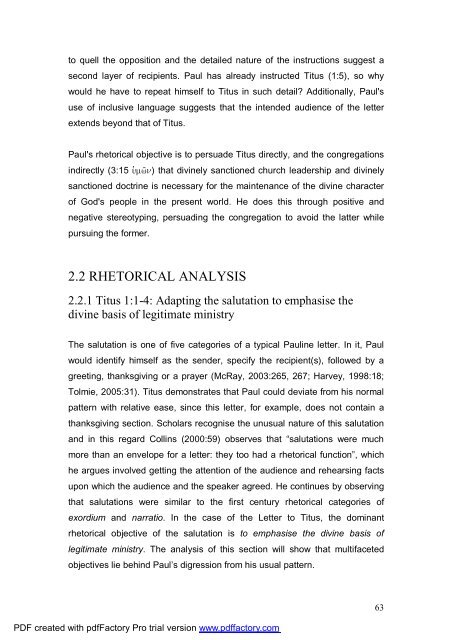A Text centred rhetorical analysis of Paul's Letter to Titus
A Text centred rhetorical analysis of Paul's Letter to Titus
A Text centred rhetorical analysis of Paul's Letter to Titus
Create successful ePaper yourself
Turn your PDF publications into a flip-book with our unique Google optimized e-Paper software.
<strong>to</strong> quell the opposition and the detailed nature <strong>of</strong> the instructions suggest a<br />
second layer <strong>of</strong> recipients. Paul has already instructed <strong>Titus</strong> (1:5), so why<br />
would he have <strong>to</strong> repeat himself <strong>to</strong> <strong>Titus</strong> in such detail? Additionally, <strong>Paul's</strong><br />
use <strong>of</strong> inclusive language suggests that the intended audience <strong>of</strong> the letter<br />
extends beyond that <strong>of</strong> <strong>Titus</strong>.<br />
<strong>Paul's</strong> <strong>rhe<strong>to</strong>rical</strong> objective is <strong>to</strong> persuade <strong>Titus</strong> directly, and the congregations<br />
indirectly (3:15 uJmw`n) that divinely sanctioned church leadership and divinely<br />
sanctioned doctrine is necessary for the maintenance <strong>of</strong> the divine character<br />
<strong>of</strong> God's people in the present world. He does this through positive and<br />
negative stereotyping, persuading the congregation <strong>to</strong> avoid the latter while<br />
pursuing the former.<br />
2.2 RHETORICAL ANALYSIS<br />
2.2.1 <strong>Titus</strong> 1:1-4: Adapting the salutation <strong>to</strong> emphasise the<br />
divine basis <strong>of</strong> legitimate ministry<br />
The salutation is one <strong>of</strong> five categories <strong>of</strong> a typical Pauline letter. In it, Paul<br />
would identify himself as the sender, specify the recipient(s), followed by a<br />
greeting, thanksgiving or a prayer (McRay, 2003:265, 267; Harvey, 1998:18;<br />
Tolmie, 2005:31). <strong>Titus</strong> demonstrates that Paul could deviate from his normal<br />
pattern with relative ease, since this letter, for example, does not contain a<br />
thanksgiving section. Scholars recognise the unusual nature <strong>of</strong> this salutation<br />
and in this regard Collins (2000:59) observes that “salutations were much<br />
more than an envelope for a letter: they <strong>to</strong>o had a <strong>rhe<strong>to</strong>rical</strong> function”, which<br />
he argues involved getting the attention <strong>of</strong> the audience and rehearsing facts<br />
upon which the audience and the speaker agreed. He continues by observing<br />
that salutations were similar <strong>to</strong> the first century <strong>rhe<strong>to</strong>rical</strong> categories <strong>of</strong><br />
exordium and narratio. In the case <strong>of</strong> the <strong>Letter</strong> <strong>to</strong> <strong>Titus</strong>, the dominant<br />
<strong>rhe<strong>to</strong>rical</strong> objective <strong>of</strong> the salutation is <strong>to</strong> emphasise the divine basis <strong>of</strong><br />
legitimate ministry. The <strong>analysis</strong> <strong>of</strong> this section will show that multifaceted<br />
objectives lie behind Paul’s digression from his usual pattern.<br />
PDF created with pdfFac<strong>to</strong>ry Pro trial version www.pdffac<strong>to</strong>ry.com<br />
63

















